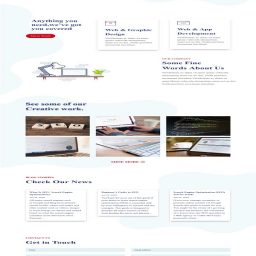Every small business needs a strong online presence, and a great website is a key part of that. An attractive and functional site is important for showing your company in the best light and attracting new customers. Great website design makes you look more professional and makes customers more willing to do business with you.
Here are 7 key steps to creating a small business website that gets results:
Get a Domain Name
A short, simple domain name makes your small business website easier to find and remember.
It is a good idea to keep checking domain registrar sites for domain name availability even while you are still deciding on a name for your website. Your first choice of domain name may already be taken, and simpler domain names can often be very expensive to register.
If your ideal name is already taken, don’t give up straight away! The owner may not actually be using it, so you should definitely visit the URL to see. Even if they are using it, they may be willing to sell the domain name to you. You can run a whois search on any domain name to find out who owns it and other useful details such as the expiry date on their ownership.
Top Level Domains
Choosing which Top Level Domain (TLD) to use is an important decision. Some of the less common TLDs such as .co, .biz and .site could make your website seem untrustworthy, as these cheaper TLDs are associated with spam or other malicious websites. Most businesses are better off using a .com or .org address wherever possible.
If your website aims to attract an audience from a specific country, national TLDs such as .de, .co.uk or .ru help to convey that you are a domestic business. These can also turn away international customers however; as they can give the impression you are only focused on doing business within that country.
Find a Web Host
Now that you have a domain name for your small business, you need to decide where your website will be hosted. There are several factors to consider when choosing a web hosting provider, including price, performance and ability to scale as your business grows, to name a few. We recommend InMotion Hosting as they provide affordable Shared and WordPress Hosting plans perfect for small businesses, but also bigger server options such as VPS and Dedicated Servers if your business ramps up to need additional resources.
Reliability
How often do their servers go down? How quickly do they respond in those situations? Are their servers regularly updated for performance and security
Location
Your server location will impact the speed of your site. Make sure your web hosting provider has server availability in a suitable location for both you and your customers. If you want to reach an international audience, you should consider hosting your site in multiple locations.
Shared Server Or Dedicated Server?
With a shared server, your website shares server hardware with other customers of your web hosting provider. This is usually much cheaper, but also means you will have less control over the speed, reliability and security of the server.
A dedicated server is more expensive, but you don’t share server hardware with anyone. This means your site speed and reliability won’t be affected by other websites, and often allows for more server storage.
Say What You Do
Visitors should know exactly what your business does as soon as they arrive on the site.
Try to sum up your business in a couple of short sentences or even bullet points, and put that on your front page without the user needing to scroll down to find it. You can provide more detailed information about your products, services and use cases in separate feature pages, but visitors won’t go to these pages without first having a basic idea of what your business is.
The average site visitor only stays on the page for 15 seconds, so you need to give them a compelling reason to stay on the site as quickly as possible.
Web Design for Small Business
The purpose of your small business’ front page should be to explain your business and why visitors need it. Similarly, every other page on your site should be designed with a specific goal in mind, whether that is educating your audience on your industry, promoting a specific product or convincing leads to provide their contact information.
- Make sure every page has a clear call to action, and that the page’s content and layout both draw your visitor to that call to action.
- Ensure your page is easy to navigate and visitors can reach pages with as few clicks as possible.
- The most important information on a page should always grab a visitor’s attention to be the first thing they look at.
A responsive navigation banner that lets users reach each section or sub-section without loading additional pages can be very useful here.
Marketing Your Small Business Website
Once you have designed your website, you can’t just sit back and wait for your audience to find it. Your website needs to be supported with marketing campaigns to raise brand awareness and attract your target customers to the site. There are several ways to do this, such as:
Content Marketing
Create engaging videos, blogs and other content targeting your customers’ interests and educating them about your business. In addition to bringing new users to your site through search engine traffic, this can help move interested leads closer to a purchasing decision.
Opt-in Marketing
Obtaining a lead’s permission to send them marketing messages via SMS can be an effective way to convince leads to buy, and keep customers returning to your site. Send personalised offers and links to content based on their interests to keep users engaged with your business, and build their trust in your brand.
Social Media Marketing
Social media marketing lets you promote your business, content and deals on platforms with millions of users. In addition, social media is also an opportunity to interact directly and publicly with potential customers, helping to establish your brand’s personality.
Create Effective Online Forms
A slow or tedious form can turn away leads and new customers, wasting the effort you put into attracting them in the first place. 27% of internet users have abandoned an online form because it was too long, and 67% of them never come back.
Keep your opt-in and sign-up forms as short and simple as possible to get more responses:
- Use fewer form fields.
Don’t present users with a long page of fields to fill in. Try not to show more than 5 fields at a time, and break the form up into multiple steps. In addition to not overwhelming your user, this also gives them an indication of their progress. - Segment leads via your online forms.
Allowing users to select their industry or interests from a list during the opt-in process helps you send them more relevant messages and marketing later on. - Use autofill.
Filling out addresses and payment information is annoying. Using a form builder that supports Google Autofill makes this much more painless.
Test and Optimize Your Small Business Site
No matter how long you spend designing your website and marketing campaigns, they will never be perfect on the first try. This is why it is so important to test every aspect of your site and study its effectiveness to make improvements.
Performance and Responsiveness
While your site might load pages quickly from your local machine, is it still fast to browse on slower computers and phones, or from a poor connection? Are page layouts correct in every screen size and internet browser?
You can emulate screen sizes of many devices through your internet browser, and simulate a poor connection by throttling the speed of your browser, however there are still going to be some issues you can’t anticipate.
User Testing
The behaviour and feedback of real users is invaluable data for optimizing your site, but you might not want early versions of your design to make bad impressions with your audience. User testing services enable you to get detailed feedback from internet users without actually launching it.
User Analytics
Once the site goes live, analyse how users interact with your site to understand which parts are achieving their intended goal and which need some improvement. Useful data to track include:
- Amount of time spent on each page.
- The percentage of page visitors that click a link or opt in.
- The link a user followed to arrive at a page.
Combine user analytics with split testing to try out your design changes and see whether it has the intended effect.
Create Your Small Business Site Today
The many website building tools available mean you don’t need technical expertise to create a great website. You do need to understand great web design and marketing however. Following these steps will help you make an effective and reliable website for your small business.







What a great service to offer not only for visually impaired people, but also for people like me who enjoy listening to things rather than reading.
Hearing your dulcet tones is always a pleasure and an added bonus Andrew!
Aww thanks, I hope to do more soon 🙂